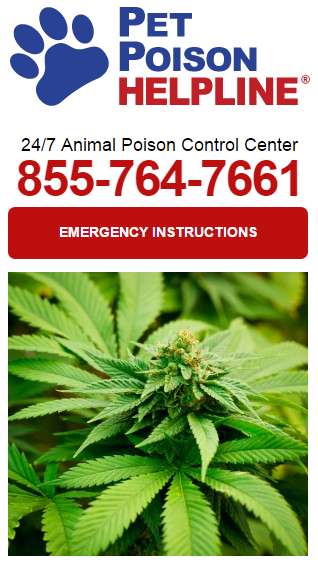 Pet Poison Helpline (PPH) has seen a 330% increase in the number of accidental marijuana ingestions in pets over the past five years which means that, undoubtedly, veterinary professionals will be seeing more marijuana ingestions too. Due to increased availability for both medical and recreational marijuana, as well as the novel forms such as foods, pills, oils, and tinctures, marijuana is more accessible now than ever. It’s also stronger; new hybrids and cultivation techniques have resulted in plants with significantly more THC (delta-9-tetrahydrocannabinol, the psychoactive compound), as compared to those in decades past. However, it’s not just plants that pets are getting into. At PPH, most cases involve pets ingesting “medibles.” These are homemade or commercial marijuana-infused foods or drinks, like brownies, cookies, gummy candy, soda, pizza, ice cream, caramel corn, chocolates, bread, snack mixes, and much more. Other novel sources of THC include highly concentrated oil products, like butane hash oil (BHO or “dabs”), filtered and purified oil (“shatter”), or wax made from whipped oil. These products are meant to be smoked via a bong (water pipe), or “vaped” like e-cigarettes in order to give users an instantaneous, powerful high. All of them contain 60-90% THC, and small ingestions pose great risk for pets. Meanwhile, as the availability of these products goes up, the stigma around marijuana use seems to be going down. This means that people are not only more likely to have a pet with an accidental marijuana exposure, but also more likely to seek help if they do. In spite of this, getting an accurate history can still be tricky. I’ve had pet owners tell me that their dogs have eaten matches, cookies, non-toxic plants carpet, paper—you name it—in order to avoid telling me that marijuana might have been involved. Usually, with a little gentle prodding and an explanation that I want to help their pets and assurance that I’m not going to report them to the authorities, the truth comes out. At PPH, 98% of our marijuana cases involve dogs, but cats should not be forgotten. A few of our notable feline cases include Puff, a cat that snuck into his owner’s purse and stole brownies made with marijuana-infused butter. Another case involved Monster, a giant of a cat that ate most of a large homemade marijuana muffin. Yet another cat, Salvador, ingested marijuana after it had been vaped, and also went on to develop intoxication. Thankfully, with supportive care, all three made a full recovery. Clinical Signs and Treatment The classic case is a dog that presents with a dazed expression, glassy eyes, incoordination, slow response times, and dribbling urine. If you couple this with a somewhat sketchy story from the pet owner, you can start to get a pretty good idea of what’s going on. Vomiting and salivation are also common signs, despite marijuana’s potent antiemetic effects. This is especially true if the live or dried plant is ingested. Other possible signs include bradycardia or tachycardia, vocalization, CNS stimulation, hyperactivity and seizures. There is some anecdotal evidence that veterinarians have lately been seeing more serious clinical signs from marijuana exposures than in previous decades. This is likely related to the increased concentration of THC in plants and products. Depending on the route of administration, the onset of clinical signs may be five to ten minutes from inhaling the smoke, or thirty minutes to several hours if the products are ingested. Thankfully, the margin of safety for marijuana is very wide, with the lethal dose being approximately 1000 times greater than the effective dose. The oral rat LD 50 is 666-1000 mg/kg, but no deaths were reported in dogs ingesting 3-9 gm/kg of marijuana. That said, while fatality is rare in pets, practioners should be alert to secondary signs or toxins which may complicate the presentation. For example, foods may contain chocolate or raisins, and severe CNS depression may increase the risk for aspiration of charcoal or vomitus. Treatment is primarily symptomatic and supportive. Decontamination may be performed if the ingestion was recent or large; either emesis or gastric lavage should be considered. Multiple doses of activated charcoal may decrease the bioavailability and half-life. Vital signs, especially body temperature and blood pressure, should be monitored and corrected as needed. CNS stimulation may be treated with diazepam. Intravenous lipid emulsion (ILE) has been tried with mixed success and, at this time, is not often recommended, but could be considered in severe cases. Recovery may take 24-72 hours, depending on the dose ingested. Medical Marijuana (AKA Medical Cannabis) Twenty-three states and Washington DC have now passed laws allowing medical marijuana use, and twenty states have passed some form of decriminalization. In spite of this, marijuana remains a Schedule I drug and possession/use remains a criminal offense under federal law. Medical cannabis contains a variety of components and extracts used to treat qualifying medical conditions which vary from state to state. In Minnesota for example, indications for the use of medical cannabis include HIV/AIDS, Tourette’s Syndrome, seizures, amyotrophic lateral sclerosis (ALS), cachexia, pain and nausea associated with cancer, and more. Some forms of medical cannabis contain THC and have psychoactive properties, while others (e.g., cannabidiol or CBD) have no psychoactive effects. Medical cannabis can come in many forms as specified by state law. In some states, patients will have full access to a suite of products from dried plants to infused foods. Other states only allow capsules, tinctures, or oils for vaporization. Marijuana alternatives (synthetic cannibinoids, K2, Spice) In 2010, herbal marijuana alternatives such as K2 and Spice became popular in the US. They were often sold in gas stations, head shops, and convenience stores, and typically marketed as incense or potpourri, with the deceptive label “not for human consumption.” Aside from containing a variety of herbs, the products also contain synthetic cannabinoid compounds, which are agonists of cannabinoid receptors (CB1 and CB2). While recent legislation in many states has severely restricted the sale of such products, they can still be purchased online, and exposures continue to be reported to Pet Poison Helpline. The majority of available information on these agents comes from human medical literature where surprising and, as of yet, unexplained symptoms have been reported. In contrast to the typical effects expected from marijuana, many human patients exposed to alternative products present with anxiety, paranoia, significant agitation and delusions. This can make them quite combative and difficult to manage. Other physical manifestations include sweating, tachycardia, dry mouth and conjunctival injection. While there is limited data on animals exposed to agents such as K2 and Spice, common signs reported to Pet Poison Helpline include ataxia, vomiting, excessive salivation, inappropriate urination, twitching, hyperesthesia, and mydriasis. No fatalities have been reported. Treatment is largely supportive and symptomatic, as no antidote is currently known. Decontamination should be performed if appropriate, and vital signs should be monitored and addressed as needed. Agitation or CNS stimulation may be treated with benzodiazepines or phenothiazines (e.g. acepromazine). Intravenous fluids should be administered in cases of hypotension or poor perfusion. Recovery may take 24-48 hrs, depending on the dose and severity of intoxication. Wrap Up Marijuana in its many forms is more prevalent and potent than ever before. Due to increased use of tasty “medibles” and highly concentrated oil and medicinal products, the risk of poisoning in pets is on the rise (especially for those pets that can’t just stop at one weed-infused cookie). For veterinary professionals, it’s helpful to be able to recognize and be ready for the signs of marijuana intoxication, especially when clients may not be forthcoming. Source: petpoisonhelpline.com A Peaceful Farewell provides compassionate at home pet euthanasia to fellow pet owners in Chandler, Gilbert, Mesa, Tempe, Ahwatukee, Scottsdale, and most of the Greater Phoenix Metropolitan Area.
0 Comments
Leave a Reply. |
The PAW Blog...
For the LOVE of Pets The goal of this blog is to help educate pet owners by sharing pet health facts and pet news articles...and ... sometimes put a smile on your face with a cute or funny pet story! Categories
All
Archives
July 2024
Search for any topic...
|

 RSS Feed
RSS Feed

